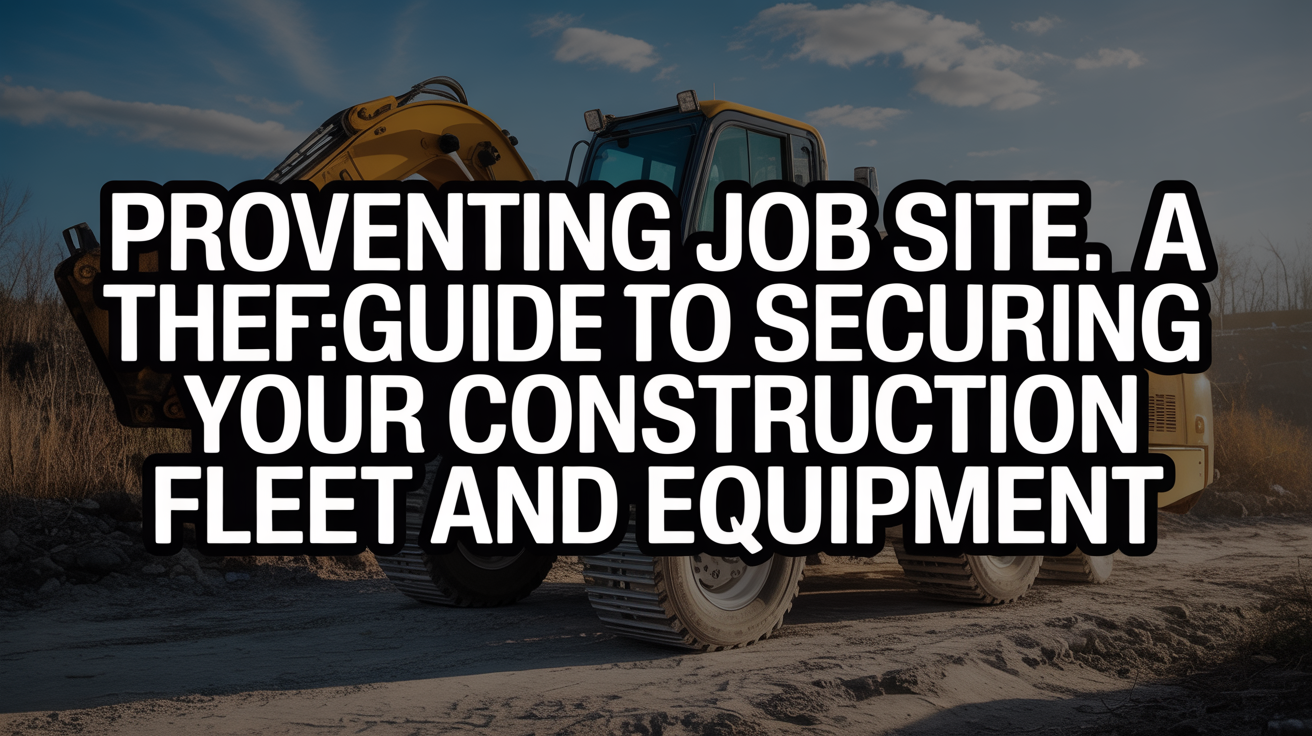Preventing Job Site Theft: A Guide to Securing Your Construction Fleet and Equipment
Introduction
Construction site theft is a growing concern that can cripple businesses financially and disrupt project timelines. Every year, millions of dollars’ worth of equipment, tools, and materials vanish from job sites, leaving contractors scrambling to recover losses. These thefts not only result in direct financial hits but also lead to delays, increased insurance premiums, and reputational damage. With the stakes so high, it’s clear why preventing job site theft needs to be a top priority for construction companies. 😬
To combat this issue effectively, businesses must adopt robust prevention strategies tailored to their unique risks. Whether you’re managing a small local project or overseeing large-scale operations, securing your assets requires a blend of physical safeguards, smart technology, and employee vigilance. By taking proactive steps now, you can protect your fleet, minimize risks, and ensure smoother operations in the long run. Let’s explore how you can fortify your job site against theft. 🛡️
Understanding the Scope of Job Site Theft
Job site theft takes many forms, but some patterns are consistently observed across the industry. Power tools, heavy machinery, copper wiring, and lumber are among the most frequently stolen items due to their high resale value and portability. Thieves often target unsecured sites, using methods like cutting fences, disabling alarms, or exploiting weak access controls. The ease with which these crimes occur highlights the need for stronger preventive measures. 🔧
Statistics reveal just how pervasive this problem is. For instance, heavy equipment theft alone costs the industry hundreds of millions annually. Trends show that urban areas tend to experience higher rates of theft, likely due to greater demand for stolen goods. Understanding these dynamics is crucial because it allows businesses to anticipate vulnerabilities and implement targeted solutions. As we delve deeper into prevention strategies, keep these common theft scenarios in mind-they’ll guide our approach to securing your assets. 📊
Perimeter Security and Physical Barriers
One of the simplest yet most effective ways to deter thieves is by establishing strong perimeter security. Fencing serves as the first line of defense, creating a visible boundary that discourages unauthorized entry. Opt for sturdy, tall fencing made from materials like chain-link or mesh, and ensure gates are locked with heavy-duty padlocks when the site is unattended. Additionally, consider adding vehicle barriers at entry points to prevent ramming attempts. These physical deterrents send a clear message: this site is protected. 🚧
Beyond fencing, lighting plays a critical role in enhancing visibility and deterring criminal activity. Strategically placed floodlights can illuminate dark corners and blind spots, making it harder for intruders to go unnoticed. On-site storage containers offer another layer of protection, especially for valuable tools and equipment. By combining these elements, you create a fortified environment that makes theft far less appealing. Now let’s talk about how lighting and surveillance systems can further boost your site’s defenses. 💡
Site Lighting and Surveillance
Lighting isn’t just about visibility-it’s a powerful psychological tool that deters potential thieves. Motion-activated lights are particularly effective, as they draw attention to movement and alert nearby personnel or neighbors. Position lights around key areas such as equipment storage zones, material piles, and entryways to eliminate shadows and blind spots. Properly lit sites are less attractive targets, as criminals prefer operating under the cover of darkness. 🌟
“Strong, tall construction site fencing can deter would-be thieves. Portable storage containers are ideal for locking up equipment after hours. They’re both effective and cheap. And don’t forget about lighting. Bright sites discourage crooks-nobody wants to steal in a spotlight.” -SiteBox Storage
Surveillance cameras take security to the next level by providing real-time monitoring and evidence collection. Modern systems equipped with motion sensors can send instant alerts to your phone if unusual activity is detected. Place cameras strategically to cover high-risk areas while ensuring they’re tamper-proof and weather-resistant. This combination of lighting and surveillance creates a comprehensive security net that not only deters theft but also aids in identifying culprits. Next, we’ll look at how marking and tracking your equipment can add another layer of protection. 📹
Equipment Identification, Marking, and Tracking
Marking your equipment with unique identifiers is a simple yet impactful way to discourage theft and aid recovery efforts. Engraving company names or serial numbers onto machinery makes stolen items easier to trace back to their rightful owners. Asset tags-especially tamper-resistant ones-serve a similar purpose, acting as visual deterrents for would-be thieves. These markings not only make reselling difficult but also provide proof of ownership during investigations. ✍️
In addition to physical markings, GPS and RFID tracking devices have revolutionized asset management and recovery. These compact gadgets allow you to monitor equipment locations in real time, even triggering alerts if an item moves outside designated boundaries (geofencing). Registering your equipment with national databases like the National Equipment Register adds another safeguard, increasing the chances of retrieval. With proper identification and tracking systems in place, you significantly reduce the risk of losing valuable assets forever. Let’s now examine how controlling access to your site enhances security further. 📍
“Security cameras help prevent theft. When positioned correctly with a view of equipment and tool storage, you can use security cameras to maximize your security and help discourage theft or identify perpetrators if theft occurs.” -Raken
Access Control and Employee Training
Controlling who enters your job site is essential for minimizing theft risks. Implementing access control measures such as lockboxes, smart keys, or biometric scanners ensures that only authorized individuals can enter restricted areas. Maintain detailed logs of who accesses the site and when, as this accountability helps identify suspicious behavior. Vetting employees and contractors thoroughly before granting them access to sensitive areas is equally important. A single lapse in vetting could leave your site vulnerable. 🔑
Training your team on security protocols is just as vital as physical safeguards. Educate workers on recognizing signs of potential theft, reporting incidents promptly, and following shutdown procedures. Encourage a culture of vigilance where everyone feels responsible for protecting company assets. When employees understand the importance of these practices, they become active participants in maintaining a secure work environment. Speaking of security, let’s discuss what to do with idle equipment to prevent unauthorized use. 👷♂️
Disabling and Securing Idle Equipment
Idle equipment left unattended overnight or over weekends is a prime target for thieves. To mitigate this risk, adopt practices that render machines temporarily inoperable. Installing immobilizers, removing batteries, or disconnecting fuses can frustrate would-be thieves attempting to start vehicles or machinery without permission. Hydraulic lock-out systems are another excellent option, physically preventing operation until reactivated. These measures ensure that even if someone gains access to your equipment, they won’t get far. ⚙️
“You can employ technology to help secure and track your equipment, not to mention aid in recovery. Aside from the aforementioned security cameras, popular tools include the telematics devices for geofencing and GPS tracking, RFID (radio-frequency identification) tracking…” -Acadia Insurance
Securing keys offsite is another practical step to enhance security. Avoid leaving spare keys on-site, as they can easily fall into the wrong hands. Instead, store them in a secure location accessible only to trusted personnel. Combining these tactics with other layers of protection-like surveillance and access controls-creates a formidable barrier against theft. In the next section, we’ll explore how advanced technology solutions can amplify your efforts to safeguard your assets. 🚜
Technology Solutions: GPS, Telematics, and Remote Monitoring
Modern technology has transformed the way construction companies protect their fleets and equipment. GPS trackers and telematics devices enable real-time location tracking, geofencing, and remote diagnostics-all invaluable tools for preventing theft and recovering stolen assets. Geofencing allows you to set virtual boundaries; if a piece of equipment crosses these limits, you’ll receive immediate notifications. Such proactive measures give you peace of mind knowing your assets are constantly monitored. 🌍
Remote immobilization systems take things a step further by allowing you to disable equipment remotely if it’s reported stolen. Some advanced setups even integrate drone surveillance for aerial monitoring of large sites. While these technologies require an initial investment, their benefits far outweigh the costs, particularly for high-value assets. By embracing innovation, you stay one step ahead of thieves and protect your bottom line. Now, let’s shift focus to the importance of maintaining accurate records and inventories. 📱
“Properly vet employees and drivers who will be responsible for equipment and vehicles.” -Acadia Insurance
Maintaining Detailed Records and Inventory
Keeping meticulous records of your assets is a cornerstone of effective theft prevention. Document every piece of equipment, including its make, model, serial number, and purchase date. Regular audits help verify that all items are accounted for and highlight discrepancies early on. Detailed documentation not only aids in day-to-day management but also proves invaluable during insurance claims or police investigations. Without proper records, recovering stolen property becomes exponentially harder. 📋
Proof of ownership is equally critical. Store copies of invoices, registration papers, and maintenance logs in a secure digital format for easy access. Consider sharing this information with local law enforcement agencies to expedite recovery processes. Maintaining up-to-date records demonstrates professionalism and preparedness, qualities that inspire confidence among clients and partners. As we move forward, let’s address how to secure your site during extended closures, such as holidays or planned shutdowns. 📅
Security Protocols During Vacant Periods and Holidays
Vacant periods pose unique challenges, as prolonged absences increase opportunities for theft. Before shutting down a site, conduct a thorough security check to identify and address vulnerabilities. Relocate high-value equipment to safer locations, such as locked storage facilities or off-site yards, whenever possible. Notify local law enforcement about your plans, as their awareness can deter opportunistic criminals. Extra precautions during these times can save you from costly surprises later. 🎄
“Keep detailed records of what the company owns and rents. A detailed record will not only help you better manage your assets, it is also the proof you need that the item belongs to you, if it comes down to needing to file a police report.” -Raken
Heightened monitoring is also advisable during shutdowns. Expand geofence parameters, schedule additional patrols, or hire temporary security personnel to oversee the site. Ensure all alarms and surveillance systems remain operational throughout the closure. Taking these extra steps might seem inconvenient, but they’re well worth the effort to safeguard your investments. With vacation season approaching, now’s the perfect time to review your protocols. Moving on, let’s discuss fostering a security-conscious workplace culture. 🏭
Developing a Security Culture and Engaging Your Team
A strong security culture starts with leadership setting the tone. When managers prioritize theft prevention and actively engage employees in related initiatives, it fosters a sense of shared responsibility. Encourage open communication by creating channels for reporting suspicious activities anonymously. Recognize and reward staff who demonstrate exceptional vigilance, reinforcing positive behaviors. A united front makes it much harder for thieves to exploit weaknesses. 🤝
Regular toolbox talks and training sessions keep security top-of-mind for your team. Discuss recent incidents, share lessons learned, and update everyone on new protocols or technologies being implemented. Empower employees to take ownership of their roles in protecting company assets. When everyone works together toward a common goal, the entire organization benefits. Finally, let’s examine the importance of conducting regular security audits and risk assessments. 🔍
“Engrave or clearly mark equipment with unique identifiers, such as your company name or logo. Use highly visible and tamper-resistant asset tags or GPS tracking devices to deter theft and aid in recovery.” -Victor Insurance
Regular Security Audits and Risk Assessments
Conducting regular security audits is essential for staying ahead of evolving threats. Walk through your site with a critical eye, assessing the effectiveness of existing measures and identifying areas for improvement. Update asset invent Much like routine maintenance keeps equipment running smoothly, audits ensure your security systems function optimally. Incorporating feedback from employees-who interact with the site daily-can uncover blind spots you may have missed. 📉
Risk assessments complement audits by evaluating emerging vulnerabilities. Factors such as changing neighborhood dynamics, project scope adjustments, or seasonal fluctuations can influence your site’s susceptibility to theft. Use these insights to refine your security strategy continually. Staying proactive rather than reactive minimizes risks and protects your business in the long term. With this foundation laid, let’s explore insurance and legal considerations for mitigating theft impacts. 🛡️
Insurance and Legal Considerations
Adequate insurance coverage is a lifeline when theft occurs, helping offset financial losses and facilitating recovery efforts. Work closely with your insurer to understand policy requirements, exclusions, and claim procedures. Ensure all equipment is properly insured, and update policies regularly to reflect changes in asset values or project scopes. Insurance alone won’t stop theft, but it provides a safety net that keeps your business afloat during tough times. 📈
Collaborating with law enforcement agencies strengthens your ability to respond swiftly to theft incidents. Build relationships with local authorities, providing them with site maps, equipment descriptions, and contact information. Quick reporting increases the likelihood of recovery and sends a message to criminals that your business won’t tolerate theft. Armed with knowledge and resources, you’re better equipped to handle whatever comes your way. Let’s wrap up with answers to some frequently asked questions. 🚔
Frequently Asked Questions
What are the most stolen items on construction sites?
The most commonly stolen items include power tools, heavy machinery, copper wiring, and lumber. These items are valuable, portable, and relatively easy to sell on the black market.
How can GPS tracking aid in equipment recovery?
GPS tracking allows you to monitor equipment locations in real time and receive alerts if items move outside designated areas. This technology significantly improves the odds of recovering stolen assets quickly.
How often should construction companies conduct security audits?
Construction companies should conduct security audits at least quarterly, or more frequently if there are significant changes to the site layout, workforce, or surrounding area.
What should I do immediately if equipment is stolen?
If equipment is stolen, notify local law enforcement immediately, file a police report, and inform your insurance provider. Provide detailed descriptions and any available tracking data to assist in recovery efforts.
Are there cost-effective theft prevention strategies for small contractors?
Yes, small contractors can adopt affordable strategies like marking equipment with unique identifiers, using basic locks and lighting, and educating employees on security best practices.
Conclusion
Protecting your construction fleet and equipment from theft requires a multifaceted approach that combines physical barriers, advanced technology, and human vigilance. From installing perimeter fencing and surveillance cameras to leveraging GPS tracking and fostering a security-conscious culture, each measure plays a vital role in safeguarding your assets. Remember, no single solution guarantees complete protection-a layered strategy is key. 💪
Now is the time to evaluate your current security setup and implement the best practices outlined here. By taking action today, you not only protect your investments but also ensure uninterrupted operations and sustained business growth. Don’t wait until it’s too late-secure your job site now and enjoy peace of mind knowing your assets are well-protected. 🚀



